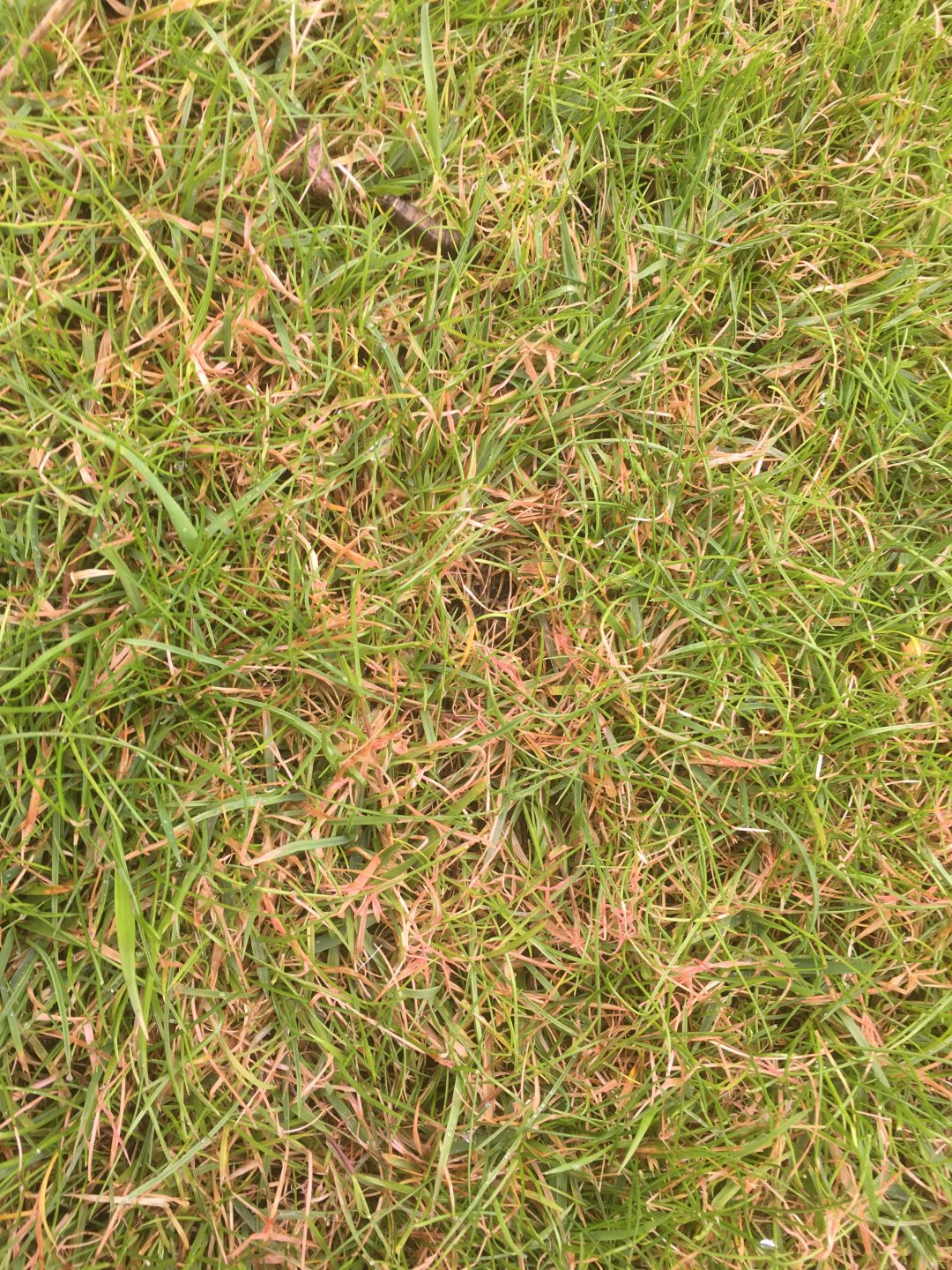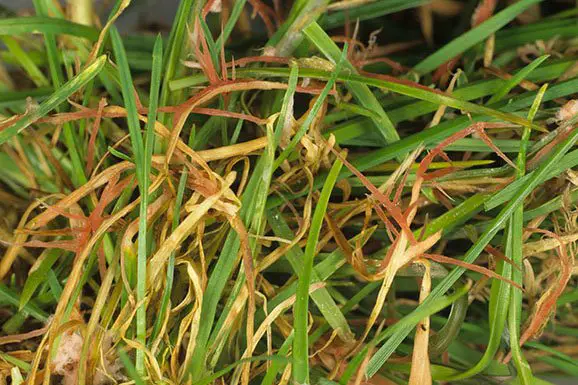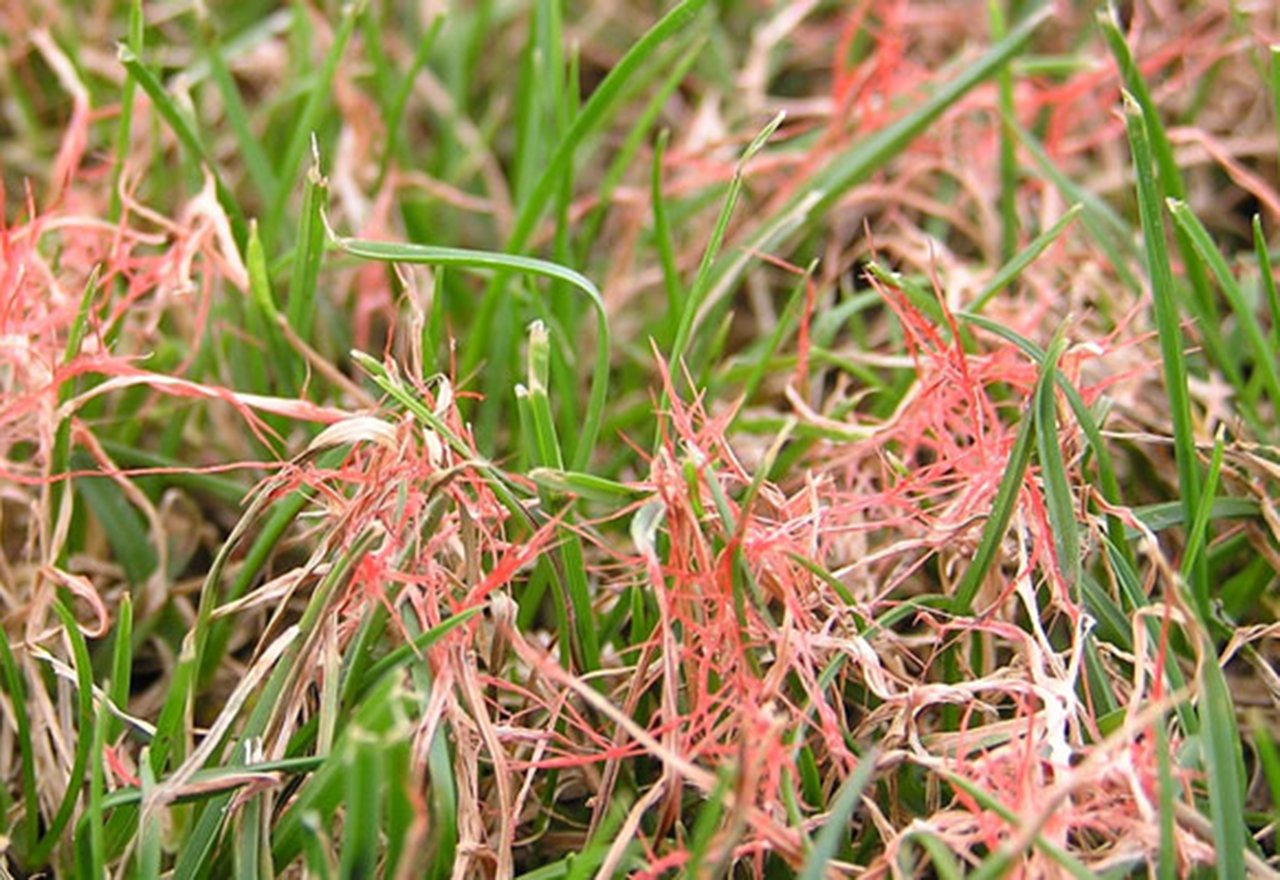Get Rid Of Red Thread
Due to the mild weather we have experienced, our Lawn Operatives are currently noticing an increase in Red Thread across lawns in the U.K. Were here to help you identify the disease in your lawn and to explain how we can help get rid of it!
What does Red Thread look like?
- Reddish/brown patches of decaying grass
- Fine red needles protruding from the blades of grass
- Pink/reddish candy-floss like particles around the base of the leaf
- Infected blades mixed with healthy blades giving the lawn a ragged appearance
In severe cases, the grass may look scorched or yellowed in irregularly shaped or circular patches from 5 to 50cm in diameter. The patches may be widely scattered or, if close together, may amalgamate into larger spots.
How did my lawn get Red Thread?
Although high humidity is the main cause, it can also be seen in lawns affected by stress related issues such as a poor cutting regime, drought, thatch, compaction, or low nutrition .
How can GreenThumb remove Red Thread?
Generally, if our customers are receiving their regular fertiliser treatments this reduces the incidence of it. However, if the problem arises due to the conditions described above, we may recommend a liquid tonic.
If Red Thread does occur, we can treat it at the same time as we apply the scheduled NutraGreen treatments to your lawn. This will ensure that your lawn has the best chance of recovery.
What can I expect after my treatment?
Did you know?
Recommended Reading: How Much Oil In Lawn Mower
Red Thread Lawn Disease
A closeup of red thread lawn disease.
Lawn diseases are frustrating for every homeowner that desires to maintain the picture-perfect lawn and landscape. Unfortunately, the warmer temperatures of the spring-time that we all love along with frequent rainy periods, creates the perfect storm of environmental conditions to be just right for fungus to grow in the lawn. A frequent spring-time lawn disease observed in many lawns is Red Thread Disease.
Protect Your Lawn With The Help Of Local Landscaping Experts
We know that maintaining a healthy lawn can be tough. Thatâs why our team at Earth Development helps businesses throughout the Midwest manage and maintain their lawns and outdoor spaces. We provide professional landscaping services at great prices.
For more advice or for a free quote, team today on 406-7501.
You May Like: Will Peat Moss Help My Lawn
What Is Red Thread And Pink Patch
Like I said at the beginning, Red Thread is the most common lawn disease in the UK.
It can appear at any time of the year but is most visible in summer. It will often appear in conjunction with another disease called Pink Patch.
Its a fungal disease caused by a fungus called Laetisaria fuciformis. This fungus is present in nearly all lawns, nearly all of the time.
Chances are that your lawn has even had a Red Thread infection in the past and youve never even noticed it. But when conditions are right, youll notice blotchy, pinky patches of dead grass as it kills the grass leaves .
Although it can infect any and all lawns, it particularly likes lawns that contain fescues, particularly Red Fescue, as well as bents, perennial rye-grass, and annual meadow grass.
The good news is that Red Thread doesnt cause significant damage like other fungal diseases so it can be fixed fairly easily.
What Can I Do To Prevent It And How Can I Cure It

In this case, the prevention and the cure are almost the same. Lawns that arent fed lack nitrogen, and this lack of nitrogen encourages the fungus to take over. Feed your lawn a nitrogen rich fertiliser to cure your red thread problem and to prevent it. We recommend our QUICK RELEASE: Spring / Summer once watered in, this granular feed will set to work on your lawn making it green once again, and red thread free!
Recommended Reading: Smallest Cub Cadet Riding Mower
What Does Red Thread Look Like
From a distance, Red Thread appears as pink to red patches from 4 to 2 ft. in diameter. When observed more closely, you will see the reddish thread-like fungal structures on grass plants. When there is dew present on the lawn, you may even see small pink tufts on these spots as well. As the fungus grows, smaller spots may turn into larger ones as they connect together to form larger irregularly-shaped areas.
What Causes Red Thread Disease
The disease is caused by a fungus. Scientific name Laetisaria fuctiformis
The microscopic spores of this fungus occur naturally in the thatch layer and in the soil. When conditions are right they will germinate. They infect the grass plants through the leaves and at the crown . Those little red threads you see are the fruiting body of the fungus and will drop spores back into the thatch layer. Spores will be washed down into the soil to begin their life cycle again.
This fungus tends to appear in spring and autumn. It likes a temperature of 12-25 degrees centigrade and wet conditions.
You are more likely to see red thread in your lawn if the soil is compacted and/or the grass is poorly nourished. Having said that, even the best maintained lawns can be affected by this disease.
In general, a healthy lawn is better able to resist the disease and will recover quicker if it is affected.
You May Like: Hu725awdbbc
Mowing Short & Regularly
This is one of the critical steps for controlling red thread in lawns. Mow your grass short at least once a week and more often when needed. This will open the grass up to air circulation, allowing it to breathe better and help prevent disease pressure.
Taller grass has more shade and dense growth, which are necessary for red thread to live and have an excellent environment to spread.
Will Red Thread Go Away
If your lawn is suffering from red thread, dont despair as your lawn will recover from this even without applying fertilizers or fungicides.
Red thread will not kill the grass roots which means that the roots will produce new green growth. The brown and pink grass will eventually rot down or be removed by a lawnmower.
Its likely that turf with a small outbreak of red thread will recover within a few weeks. Larger outbreaks probably wont recover for a few months or until the beginning of the next growing season.
Laetisaria fuciformis will always be present in the majority of lawns so the best course of action is to prevent it from infecting your grass by removing the conditions that allow it to take hold.
report this ad
Recommended Reading: How To Kill Wild Violet Weeds
What Causes Red Thread
Red thread is a disease of turfgrass that is often associated with under-fertilized turf and one of the simplest recommendations to alleviate disease pressure is to fertilize. But it goes deeper than that.
Red thread loves Michigan summers. The days get very warm and the nights are cooler. These temperature changes often create a moist environment that fungi love, and its a perfect opportunity for them to invade your lawn. The red thread also favors cool-season grasses, such as Kentucky bluegrass, tall fescue, fine fescue, and perennial ryegrass.
How Do I Get Rid Of Red Grass
To get rid of red grass, fertilize your lawn with high nitrogen fertilizer because red thread occurs on a low nutrient lawn. The other thing you can do to remove red thread fast from your lawn is to apply fungicide in your lawn, which will remove the disease faster from the lawn but can cause some temporary damage to the lawn.
Don’t Miss: Hydro Seeding Existing Lawn
How Long Does It Take To Go Away
Within a few weeks, you should notice the effects of red thread begin to lessen, i.e less visibility of red needles, and the patches should start to green up again. Of course, this is dependent on the type of fertiliser you choose and how fast it works. If you want the quickest solution make sure to invest in a quick release fertiliser.
What Kind Of Grass Is Prone To Red Thread Fungus

Technically all kinds of turfgrass are prone to developing the growth of the red thread grass fungus, but there are some kinds of grass that appear to be more likely to be affected.
These include:
- Bermudagrass
- Bentgrass
Whether you have these kinds of turfgrass or any other, itâs important to understand how to prevent developing this strange grass with red tips and what you can do if you ever notice it on your lawn.
Also Check: How To Get Rid Of Wild Violets In Your Yard
What Is A Red Thread
Red thread disease is one of the common fungal diseases in the lawn. This disease is caused by a fungus called Laetisaria Fuciformis. This disease is most prone in water-soaked lawns in cool and humid weather. You will see some red thread-like branches coming off from the top of the leaves.
The red thread is sometimes confused with a similar-looking disease called pink patch. Pink patch disease is caused by a different fungus called Limonomyces Roseipellis. Both of the diseases are very closely related and have similarities in the disease cycle, epidemiology, host range, and appearance.
How To Spot Red Thread Lawn Disease
The earliest indicators of infection in your lawn are little uneven patches of brown or yellow grass that appear randomly over the field. If you look closely, you will be able to see either the small red needles or the second type stage where the pink downy mycelium is visible. Infection grows from tiny patches to huge brown regions, which eventually combine to create vast brown swaths.
Recommended Reading: American Made Mowers
What Damage Can Red Thread Do To Your Lawn
Despite the fact that the grass in the afflicted regions seems to be lifeless, red thread does not kill the grass since the pink growths on the grass do not infect the plants crown or roots, the fungus does not cause the grass to die as a result of its presence. The infected grass is disseminated by the fungus that resides inside it, which spreads via the thatch and soil.
Because of this mowing and other mechanical lawn care processes can easily transfer the fungus to other areas of the grass. It is therefore important to properly clean your equipment after use. If you employ a lawn care company then you should make sure they do the same.
When Its Dry Water Your Lawn Deeply Once A Week In The Mornings
Watering the lawn is one of those tasks that is so simple, yet many people get wrong.
When the weather is dry, millions of gardeners all over the UK flock out to their lawns and give them a sprinkling with their hosepipes.
This will almost guarantee that your lawn will get an infection of Red Thread and/or Pink Patch.
The whole point of watering the grass is to make the soil moist so the grass can absorb it via its roots. Watering your lawn lightly in the evenings does nothing more than wet the grasses leaves, giving the fungus the moisture it needs to incubate and grow.
In order to get that moisture into the soil, you need to water heavily, to a depth of between 1-2 inches. That means watering the lawn once a week for about an hour.
And water the lawn in the mornings. Any moisture left on the grass will be dried by the days sun instead of being used to incubate fungal disease.
Read Also: Gnat Repellent Home Depot
How To Fix A Brown Patch In Your Lawn + 4 Other Common Lawn Diseases
- May 28, 2020
Youre using your electric lawn mower regularly, watering on a schedule, and using the best lawn fertilizers. Even with all of this care, you might still find patches that look dead or discolored.
In attempts to restore these areas of the lawn, you might try to water more or you might use some type of lawn repair formula. These simple solutions might work to address some issues with dead or brown grass. However, there are lawn diseases that will get worse if you try these common solutions.
If that is the case, your lawn is probably infected by some type of grass fungus. Many of these grass diseases will actually feed off the extra water and fertilizer you apply, and this could result in more discoloration or dead spots in the lawn.
In this post, we are going to look at how to fix brown patches in a lawn and other common lawn diseases. Among the most common grass diseases are red thread, summer patch, powdery mildew, and dollar spots.
What Can You Do Now About Red Thread
To help protect your lawn from Red Thread we recommend the following.
Recommended Reading: Houseplant Sticky Stakes Lowe’s
How To Identify And Control Red Thread
Here are some ways to be confident you have red thread, plus tips for getting rid of it.
The first time you see a red-pink patch of grass in your lawn, you may think its just the way the light is hitting it. But when you take a closer look, you may notice that its different from your normal green grass. The cause could be a grass disease called red thread, named for the reddish pink, spiky threads often found clinging to, or extending from the tips of, the grass blades. Those blades may even have small, cotton-candy like strands wisping around them.
Red thread certainly has a distinctive look to it, but it may still be hard to identify if you are unfamiliar with the disease. Here are some ways to be confident you have red thread, plus tips for either reducing the severity of the disease or getting rid of it altogether.
Environmental Conditions That Are Advantageous To Red Thread

Red Thread lawn disease thrives best when temperatures are between 59 and 77 degrees Fahrenheit and when it is rainy. Under these conditions the laetisaria fuciformis that causes red thread disease becomes active and can easily spread.
It is therefore during the spring and autumn, when rainfall is heavier and temperatures are a little lower, that provide the most ideal conditions for Red Thread. The rate of development of the fungus reduces dramatically when temperatures are beyond 77°F, and it unable to grow above around 85°F.
The disease attacks those regions of a lawn that are deficient in nutrients or that develop slowly are those that are more prone to red thread disease.
The sclerotia, thread-like red webbing structures that support the fungus, are the source of the fungus growth ans there can spread easily through the air. It is possible for sclerotia to persist for months or years under grass blades, if there is strong thatch, or in the soil. The pathogen can be transmitted in various ways but the most common are contact with polluted water, wind, and gardening equipment.
Because this fungus may persist for extended periods of time, it is critical to look to deal with any affected regions quickly in order to prevent the fungus from spreading further.
You May Like: What Is The Average Cost Of Trugreen
Apply A Fungicide In The Spring And Autumn
Most people only react to Red Thread and/or Pink Patch when they see an outbreak.
However, one of the best ways to avoid an outbreak altogether is to apply a fungicide in the Spring and Autumn .
Provanto Lawn Disease Control can be applied twice a year so why not apply it as a precautionary measure? Itll cost less and cause less stress than an outbreak would.
What Is Red Thread And What Does It Look Like
Red thread is a lawn condition caused by a fungus called Laetisaria fuciformis, that attacks the leaf parts of the grass and causes it turn red and slowly die.
It is particularly a problem for fescue and perennial rye grasses, although other grasses can be affected too.
The fungus that causes red thread is present in all lawns however it stays dormant for the majority of the year.
Red thread is more common during the months of late summer and early fall/autumn as the weather is generally damp and warm. The fungus loves these humid conditions and therefore spreads it spores during this weather period.
So how do you spot that your lawn is suffering from red thread?
First of all you will notice that small yellow and brown patches are appearing on the lawn. These will range in size from between 3 inches and 7 inches in size.
The brown patches might begin to multiply or get larger however they will stop eventually as the weather becomes drier or cooler.
On close inspection, the tips of the grass blades will have a pinkish-red tip. The tip will likely have a feathered appearance and could be tangled to a neighboring grass blade. This will give the grass a matted effect that isnt pleasant to look at.
Eventually, the grass blades will dry out and die.
Next, lets see how we can get rid of red thread from your lawn.
Recommended Reading: Hydroseed Rental Home Depot
Red Thread And Pink Patch
Red thread is caused by the fungus Laetisaria fuciformis. Pink patch, caused by Limonomyces roseipellis, is a different disease which closely resembles red thread. Pink patch was once considered to be a form of red thread due to similarities in symptoms, disease cycle, epidemiology, host range, and appearance. While the two diseases sometimes occur together, pink patch is uncommon in the Northeast. Both diseases occur on turf that is growing slowly because of low fertility, lack of sunlight, drought, or other sources of stress.
